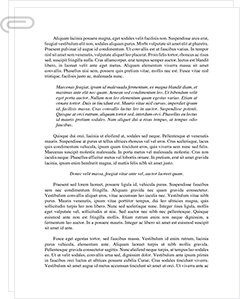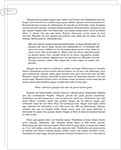 Study Document
Study Document
Social Determinants of Care in Florida Essay
Pages:5 (1591 words)
Sources:5
Document Type:Essay
Document:#66429305
Social Determinant of HealthSt. Mary's Community Health Clinic, located in Miami, Florida, serves low-income families within the community in Miami. The social determinant of health (SDOH) that will be discussed in this paper is access to healthcare.Access to healthcare is a significant social determinant of health that affects low-income families in Miami (Taylor et al., 2021). These families often face barriers such as lack of insurance, transportation issues, and limited availability of medical facilities, leading to disparities in health outcomes.Health Inequity FactorsSocial factors contribute to health inequities among low-income families in Miami, as many of these families are Hispanic and experiencing language barriers that keep them from communicating well with English-only speakers in healthcare clinics. The social factor of language, therefore, prevents some from gaining access to care. It can be a root cause of misunderstandings, misdiagnoses, inadequate treatment, or no treatment at all. Some people do not realize the barrier that language can bebut it is all too real for many who do not speak the common language of the majority (Palmer-Wackerly et al., 2020).In addition to language, the social factor of discrimination and bias against minority groups can be a cause of unequal treatment within the healthcare system. Due to a perception of bias, Hispanics may be reluctant to seek treatment. Prejudice breeds fear, and represents yet another barrier to equitable health outcomes (Palmer-Wackerly et al., 2020).Cultural factors also contribute to health inequities. Cultural beliefs and practices can sometimes prevent people from seeking medical care in a time of need, or from adhering to prescribed treatments if they are out of step with traditional customs or practices (Windsor et al., 2022). Some cultural norms may put emphasis on using traditional ancient remedies instead of using modern medicine or modern interventions. If there is no trust in modern care, the culture typically has something to do with it. The outcome is that care is delayed. Likewise, family situations can affect healthcare decisions and access, since, i many cultures, family roles and responsibilities can dictate who in the family gets to obtain care, which can, again, delay necessary medical attention.Environmental factors are also impactful for low-income families. Poor housing quality and overcrowded living conditions contribute to health problems like respiratory issues and infectious diseases. Low-income neighborhoods tend to have a high exposure to pollution, which can cause existing health conditions to become worse and can even increase the risk of developing new health issues (Jbaily et al., 2022). These types of situations add to the overall health disparities experienced by such communities.Economic factors can be the biggest contributors to health inequities, simply because financial burdens tend to limit access to healthcare, to nutritious food, to green spaces where there can be exercise, and to other necessities helpful for maintaining good health. Many low-income families hold jobs that do not provide health insurance benefits, which makes it difficult for families to afford medical care or preventive health services.Positive ImpactsIn spite of the negative aspects of SDOH there can be some positive impacts on individual health. Strong community networks and social support can sometimes be found in these communities, which may in turn be a source of emotional and social support. Also,…
…data and personal stories to show the impact of the mobile unit on community health, and how it can reduce healthcare costs and improve public health. The campaign will also target healthcare providers to get participation in the mobile unit's efforts.Influential Factors in AdvocacyThe success of the advocacy campaign among the local population may be influenced by historical mistrust in the healthcare system. This mistrust can affect the community's willingness to engage with the mobile unit. To counteract this bias, the campaign will emphasize the mobile unit's commitment to community-oriented values and its dedication to serving the underserved. Through the attention given to this issue, the campaign can be able to improve acceptance and trust within the community.As an advocate, personal commitment to social justice and health equity will support the advocacy work, and this commitment will also help with lining up the initiative with ethical standards and goals. The belief in the importance of preventive care and early intervention will guide the campaign, and will be expressed in the benefits of the mobile unit in providing timely and essential healthcare services.Political organizations' support for the mobile unit initiative can be influenced by biases and political agendas. These biases can impact the level of support and funding available for healthcare initiatives. To address these challenges, the campaign will use evidence-based arguments and highlight the cost-effective outcomes of the mobile unit. In lining up the initiative with broader public health goals and showing its potential to improve community health, the campaign can attract political support. Showing how it supports public health objectives can help reduce any political biases…
Related Documents
 Study Document
Study Document
Social Determinants of Disease and the Measles Outbreak
Measles OutbreakIntroductionIn 2019, the United States experienced a significant measles outbreak that swept across various states, including the CDC\\\'s Region C, with a notable impact in Florida. This paper discusses the Measles outbreak in CDC Region C during 2019 by looking at the specifics of the outbreak, the timeline of the outbreak\\\'s discovery, and its spread to other regions. It also describes the risk factors associated with the outbreak, the
 Study Document
Study Document
Social Skills in Alternative Education:
.." As well as having problem with self-expression both of which affect the individual's interpersonal communication. For example, the child with Attention Deficit Hyperactivity Disorder (AD/HD) may be "inattentive, impulsive, hyperactive - or any combination of these." (Stanberry, 2002) the work of Stanberry (2002) states that there are three elements of social interaction which include the following three: Social Intake - noticing and understanding other people's speech, vocal inflection, body language,
 Study Document
Study Document
Insights on Access to Care During COVID
How Did Mayor Bill de Blasio�s COVID Lockdowns Affect Access to Healthcare for the Minority Population in Tremont?Chapter 1IntroductionThe panic regarding the 2020 COVID-19 pandemic led to new administrative challenges regarding protecting and serving communities at the same time. Many cities across America reacted to COVID by trying to curb the virus\\\'s spread through the implementation of lockdowns. Local governments implemented strict measures that changed daily life overnight and exposed
 Study Document
Study Document
Mental-Health Care for Mexican-Americans With
Who lives with you in your household? Quien vive con usted en la casa? B. Tell me about your family. Cuenteme acerca de su familia C. What's a typical day like for you? With your Family? With your friends? Como pasa Usted el dia? Con su familia? Con sus amigos? D. Tell me about your friends Cuenteme sobre sus amigos E. Who are the people you can count on the most in time
 Study Document
Study Document
Healthcare in Saudi Arabia Project
Lack of accountability, transparency and integrity, ineffectiveness, inefficiency and unresponsiveness to human development remain problematic (UNDP). Poverty remains endemic in most Gulf States with health care and opportunities for quality education poor or unavailable, degraded habitats including urban pollution and poor soil conditions from inappropriate farming practices. Social safety nets are also entirely inadequate and all form part of the nexus of poverty that is widely prevalent in Gulf countries.
 Study Document
Study Document
Critical Care Nursing Regarding Legal
The questions on legal liability issues were minimal as the field of legal issues is new in nursing. The questions addressed a theoretical part regarding the legal liability issues. They were no need of clarification since the questionnaires were easy and self -- administrative. Although the researcher was there for assistance but telephonically. 1.7. Data analysis In this chapter, the analysis is discussed in detail. Data was collected by means of




